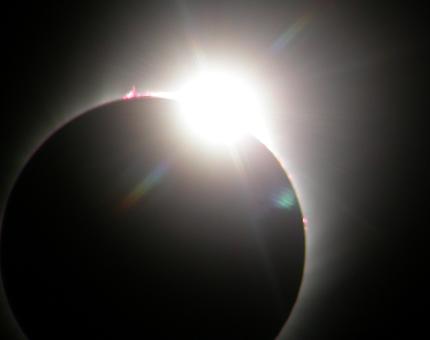Solar eclipse in Antalya, March 2006. A special report for the Hedan site
Avi Belizovski, Sida, Turkey

the diamond ring Dr. Emmanuel Gringard managed to capture the second particle in which the sun struggles in its last eruptions to be revealed beyond the moon.
Good things pass quickly. They say it was three minutes and 42 seconds. To me it seems maybe like 20 seconds. Darkness in the sky, and a cold that came suddenly after a relative heat wave (the fact that I got sunstroke). And what you see above is something very strange - a hollow circle of light. The lighting was about the same as that of a full moon night, because after all there is a little light even in the crown of the sun.
We settled on a sand dune overlooking the Gulf of Antalya in the ancient Roman city of Side. Below us is also the Roman stadium, inside which NASA scientists were stationed and from where they broadcast the eclipse live on television and on the Internet to the whole world.
The weather cooperated in a remarkable way, the lectures conducted by Dr. Eyal Hefetz using a model called Skiron at the University of Athens revealed that it is better to go to the coast and not to the mountains, even though intuitively it seems that a high place may contain less clouds. "We are at the end of the winter season and the sea is relatively cold. We expected that in terms of low cloudiness on the coastline it would be clean and there would be low cloudiness in the mountains. On the other hand, high clouds - a feather (cirisos) the forecast was that it could reach the coastline and disturb. Exactly according to the forecast, these clouds came from the northwest, but fortunately they are still there and do not prevent us from seeing the eclipse. The model predicted it exceptionally well. This wave will move towards us, but it will arrive already in the afternoon. The model is every 6 hours. At six in the evening the clouds are already in our area."
The organizers led by Ofer Yaron succeeded in their mission. About 140 members of the group arrived at the place in three buses from the hotel in Antalya. Everyone was disciplined and we left around eight in the morning, and we even managed to visit the Mangabat Dam, a huge dam whose water depth in the lake formed inside it reaches 130 meters, and the amount of water that passes through it during a year is double what the State of Israel uses for all its consumers during a year. Later we settled in Sida, and reached the hill occupied by Holit Halutz.
About an hour and a half before the eclipse, the excitement began when the first contact was made around four o'clock (not on the clock but on the sun wheel). Little by little, the excitement grew as more and more signs began to herald a change, and not just the image of the biting sun wheel slowly turning into a crescent, as seen through the special glasses and devices that project the sun. Towards a quarter to two, about ten minutes before the eclipse, it got cold and the sky got a little dark, like in the twilight hours. Even the horizon was pink. Then about five minutes before two, it happened - almost at once everything went dark. A look at the sun showed that it was trying to burst through the moon covering it. The Bailey ring as it is called - the strange light in the sky that I talked about at the beginning, could be seen with the naked eye. It's not something you're used to watching. Exclamations of admiration were heard from all sides, and even professors were as excited as children.
It's hard to put into words this feeling, it's really not like seeing it on TV or on the internet. it was worth it. An experience out of this world, literally.
Report as delivered on the website around 13:15 Israel time. Delivered by phone and uploaded by Amit Oren
Avi Blizovsky tells about the peak of the eclipse as seen from the vantage point of the Tel Aviv University group in Turkey
(Amit Oren)
At the moment of the peak of the eclipse, when the sun was completely covered, the temperature dropped from 24 degrees to 13 a second before the eclipse had enough light. Along the way, people were enthusiastic, and used a variety of equipment to photograph and observe the eclipse. degrees. At the peak moment - it got dark. Although, not as expected, not so many stars were seen in the sky, Venus was seen and several more. You can say it's like seeing the desert sky with the moon in it. During the Great Darkness, the peak, people used flash for photography, because the cameras are programmed according to the light. At the peak, the view was amazing! Like a ring of light, you could actually see the point from which the sun's rays came out. The exit of the sun from the cover was an amazing sight, like a sparkling diamond.
The group from Tel Aviv University in Turkey arrived yesterday until Saturday evening. Their group contains about 140-150 people.
A special expert - solar eclipse in Antalya 2006
